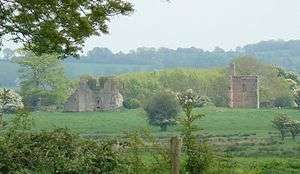Tristernagh Abbey

Tristernagh Abbey, also known as the Priory of Kilbixy, is a ruined Augustinian priory, situated on the shores of Lough Iron about 3 kilometres (1.9 mi) north east of Ballynacargy in County Westmeath, Ireland. The abbey was founded in 1192 by Geoffrey de Constantine and was dedicated to Mary.
The first prior on record was named Henry, possibly a relative of the founder. Several of the Bishops of Ardagh and Meath were benefactors of the priory during its history.[1]
The abbey was ransacked by the commissioners of King Henry VIII in 1536 and closed down; its land was subsequently granted to William Piers by Elizabeth I. There was formerly a tradition in Kilbixy parish that at the time of the Reformation the Friars had removed the Abbey bells and thrown them into Lough Iron.[2] According to a memorial inscription in the ruined church of Templecross nearby, the Abbey was repaired by William Piers' son Henry Piers, who converted to Catholicism in later life. It is also possible that the monastery was returned to religious use during the Confederate period.[2] The ruins of the abbey were described as still very substantial in 1682 by their then-owner Sir Henry Piers, but were largely pulled down by one of his descendants, Sir Pigott Piers, in 1783 in an act later described, by topographer James Norris Brewer as "an outrage [...] the name of Tristernagh should never be mentioned without an expression of contempt [...] towards that of Sir Pigott William Piers".[3]
The Piers Baronets, of Tristernagh Abbey is an extant peerage in the Baronetage of Ireland.